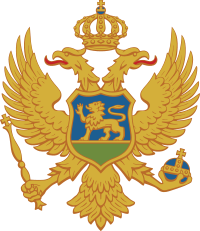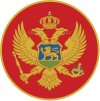- Coat of arms of Montenegro
-
The coat of arms of Montenegro (Montenegrin: Грб Црне Горе, Grb Crne Gore) was officially adopted by the law passed in the Parliament on 13 July 2004. It is now the central motif of the flag of Montenegro, as well as the coat of arms of the Army of Montenegro. It was constitutionally sanctioned by the Constitution proclaimed on 2 October 2007.
Contents
Description
The charge is a two-headed eagle which is a symbol of Byzantine and ultimately Roman origin. It symbolises dual authority, such as that over the church and state. The motif was used by medieval rulers of Zeta - the House of Crnojević, as well as various other European dynasties. The layout of the Montenegrin coat of arms is inspired by that of the Russian Empire, with which the ruling House of Petrović-Njegoš had close dynastic and political ties in the 19th century when the coat of arms was first adopted in its present form.
The lion passant on the inescutcheon can be interpreted in several ways. It can be seen as a sign of episcopal authority and could be inspired by the Lion of Judah. Furthermore, it bears some similarity to the motif present in the arms of Venice, which had considerable influence in the history of Montenegro. After Montenegro regained its independence, it gradually became a theocracy in order to preserve unity before numerous Turkish invasions on the country. For this reason, the authority of the church was reflected in various insignia of the age. After the establishment of the secular dynastic succession in 1851, the lion was placed beneath the eagle, while the initials of the ruler stood on the shield: notably, that of Danilo I, Prince of Montenegro, Danilo II, Prince of Montenegro and King Nicholas I of Montenegro. Curiously, Danilo I was still a prince-bishop while the standard bearing his initials was used. The modern coat of arms placed the lion d’or back on the shield, erasing that monarchic symbol. Today, Montenegro is a secular, democratic republic, so the fact that the crown of the Petrovic-Njegos dynasty was also represented created some controversy at the time of its adoption. However, this solution proved extremely popular and the coat of arms can be seen not only in schools, government offices, etc, but also in many private houses, places of business and private universities and is a common display of national pride.
Use of national symbols (as per Montenegrin laws)
The coat of arms and the flag are used in the shape and contents determined by law. The use of the coat of arms and the flag is free in artistic creativity and educational work, in manners not disturbing the public morale, reputation and dignity of Montenegro. In the coat of arms and the flag, it is not permitted to correct, add or change anything. Exceptionally, if so determined by special regulations, the coat of arms and the flag could be used as a component of other emblems or signs of the state bodies and other institutions. The coat of arms and the flag can not be used as merchant or service seal, sample or model, nor as any other sign marking the merchandise and services. The coat of arms and the flag cannot be used if they are defective or otherwise inappropriate for use due to the unsuitable appearance. A defective or unsuitable for use coat of arms or flag are revoked from use.
When displayed in Montenegro together with one or more coats of arms of other states or international organizations, the coat of arms takes the place of honour. The place of honour is considered the central place in a circle, the top of the semicircle, the first place in a row, column or group of coats of arms, the place on the right, as seen from the front, from the coat of arms of another state or international organization. On scripts it takes place on the top center or upper left angle.
The coat of arms is used
- In the state seal;
- In the seals of other state bodies and local self-management bodies;
- In the official halls of the state bodies and the local self-management bodies and on official inscriptions on the buildings in which these are located;
- In rooms of educational institutions in which the educational process is performed and on inscriptions on buildings in which these institutions are located
- On buildings of the representations of Montenegro abroad;
- On official acts used by the representatives of the state bodies;
- On charters, diplomas and recognitions granted by Montenegro;
- On diplomas and attestations on finished education;
- On identity cards of members of the parliament, members of the government, judges, inspectors and other officials.
The coat of arms may be used
- During political, scientific, cultural, artistic, sporting and other manifestations in which Montenegro is represented;
- On official acknowledgments, greeting cards, invitations and other acts of the President of Montenegro, the Chairman of the Parliament, the Prime Minister, the Chairman of the High Court, the Chairman of the Constitutional Court, the Supreme State Attorney and the Human Rights Ombudsman;
- On official uniforms;
- In artistic creations and in educational work;
- In other cases defined by the law.
Historical coats of arms
The history of the state coat of arms begins with the Crnojevics dynasty in the 15th century. Their family arms - a golden crowned two-headed eagle on a red background - laid the foundation of the Montenegrin state heraldry: the two-headed eagle became the standard symbol of the state. After gaining power, the Petrovic-Njegos dynasty took the golden two-headed eagle as the state symbol. Vladika Danilo charged on its breast the Great Arms of the Petrovic-Njegos family (shield, crown, mantling), while his successor vladika Sava made major changes to the coat of arms: he removed the family Great Arms from the eagle's breast, and added a sceptre and a globus cruciger ("the imperial orb") in its claws. He also added another symbol retained until present day - a golden lion passant - below the golden eagle. With Petar I, further rearrangement of the coat of arms took place: he removed the royal insignia from the eagle and charged the eagle's breast with the Middle Arms of the Petrovic-Njegos while leaving the lion passant.
Prince Danilo also reorganised the coat of arms: he charged the golden eagle's breast with a shield with a blue background and a golden lion passant on green ground. In one claw the eagle held the orb, and in the other a sword and a sceptre.
In the time of King Nicholas I, the sword was removed and later, in conformity with the Constitution of 1905, the colour of the eagle was changed from golden to silver as well as the colour of the inescutcheon - from blue to red. [1]
After World War II, Montenegrin statehood was reestablished and Montenegro became a federal part of the Second Yugoslavia. A national emblem was adopted in 1945 and it was designed in socialist style: Laurel wreath with Red Star, while the central motive was the Chapel of Lovćen with sea waves in the background, representing the Montenegrin sea access. The national emblem of the Federal State of Montenegro was made in 1944 by Milan Božović, it was stylised in 1946 by Milo Milunović, and afterwards slightly changed in 1963 and 1974 (the shape of the red star).
In 1993, the Montenegrin parliament introduced a coat of arms proper, returning to historical heritage. The old Montenegrin state's coat of arms was restored, but redesigned in the style of the federal coat of arms. The Constitution of 1993 maintained the "tradition" of king Nikola: the adopted coat of arms was a crowned silver eagle with the orb in one and the sceptre in the other talon, and charged on its breast was a red shield with a golden lion passant.
-
Coat of arms of the Principality of Montenegro (1905-1910)
-
Coat of arms of the Kingdom of Montenegro (1910-1918/1922)
-
Emblem of the Socialist Republic of Montenegro (1963-1974)
-
Emblem of the Socialist Republic of Montenegro (1974-1993)
-
Coat of arms of Republic of Montenegro (federal) (1993-2004)
See also
- List of coats of arms of Montenegro
- Lion passant
- Double-headed eagle
References
External links
 Montenegro topics
Montenegro topicsHistory Praevalitana · Duklja · Principality of Zeta · Sanjak of Montenegro, Ottoman Empire · Principality of Montenegro · Kingdom of Montenegro · Kingdom of Yugoslavia · Zeta Banovina · Kingdom of Montenegro (1941-1944) · World War II · Socialist Republic of Montenegro · Montenegrin independence referendum · MontenegroGeography Topography · Mountains · Extreme points of Montenegro · Islands · Rivers · Lakes · Climate · Protected areas · Flora · FaunaPolitics Economy Euro · Montenegrin perper · National Bank · Education · Communications · Tourism · Transport · CompaniesMilitary Symbols Demographics Administrative divisions · Cities · Human rights · Postal codes · Languages · Religion · Montenegrins · List of MontenegrinsCulture Academy · Architecture · Art · Cinema · Music · Cuisine · Montenegrin language · Literature • Poets · Philosophy · Folklore · Media (Television • Radio) · SportWikiProject · PortalCoats of arms of Europe Sovereign
states- Albania
- Andorra
- Armenia
- Austria
- Azerbaijan
- Belarus
- Belgium
- Bosnia and Herzegovina
- Bulgaria
- Croatia
- Cyprus
- Czech Republic
- Denmark
- Estonia
- Finland
- France
- Georgia
- Germany
- Greece
- Hungary
- Iceland
- Ireland
- Italy
- Kazakhstan
- Latvia
- Liechtenstein
- Lithuania
- Luxembourg
- Macedonia
- Malta
- Moldova
- Monaco
- Montenegro
- Netherlands
- Norway
- Poland
- Portugal
- Romania
- Russia
- San Marino
- Serbia
- Slovakia
- Slovenia
- Spain
- Sweden
- Switzerland
- Turkey
- Ukraine
- United Kingdom
- (England
- Northern Ireland
- Scotland
- Wales)
- Vatican City
States with limited
recognition- Abkhazia
- Kosovo
- Nagorno-Karabakh
- Northern Cyprus
- South Ossetia
- Transnistria
Dependencies
and other territories- Åland
- Faroe Islands
- Gibraltar
- Guernsey
- Jan Mayen
- Jersey
- Isle of Man
- Svalbard
Other entities Categories:- National coats of arms
- Montenegrin coats of arms
- National symbols of Montenegro
Wikimedia Foundation. 2010.









